Get excited.
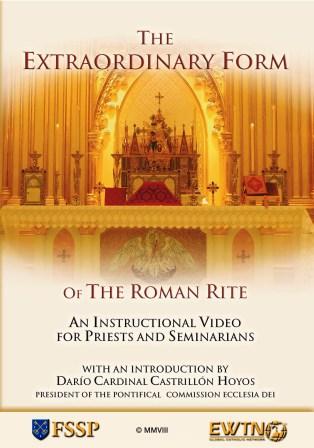 Mr. FedEx came today to present me with a package sent by the estimable Fr. Justin Nolan, FSSP, whom I interviewed for a PODCAzT.
Mr. FedEx came today to present me with a package sent by the estimable Fr. Justin Nolan, FSSP, whom I interviewed for a PODCAzT.
Fr. Nolan sent me an advance copy of their long-awaited instructional DVD for priests who desire to learn the older form of Mass.
The fuller title is The Extraordinary Form of the Roman Rite, an Instructional Video for Priests and Seminarians.
This DVD is stunning in its production values and its detail. It is easy to follow, well explained, beautifully recorded. This is a must obtain for priests, must give to seminarians, must be used by them set of disks.
I have been contending that Summorum Pontificum is primarily a gift for priests. Learning to say the older form of Mass changes a way a priest sees Mass and therefore sees himself. The flocks entrusted to the priests who come to this new understanding will in their own turn be affected. The DVD is therefore an essential tool in carrying out what I believe is Pope Benedict’s "Marshall Plan" for the Church, especially though a revitalization of her liturgical life.
The advance copy does not have the packaging or artwork but the content is identical to what will be released.
Many priests have already pre-ordered this DVD, which the FSSP is sending them for free. They still have a limited supply of free copies available to priests, first-come-first serve.
Special bulk order pricing is also available for dioceses and re-sellers. Contact Faye Trgovac at Fraternity Publications for more infromation: (570)842-4000 ext. 401 or email: publications@fssp.com
Shipping is to begin on 20 November to those who pre-registered. The DVD will be available for US$ 29.00.
There is a Spanish audio track along with English. They will make an international edition with French, German, Italian and Portuguese for the first quarter of next year. They are also making a version in Mandarin and Cantonese.
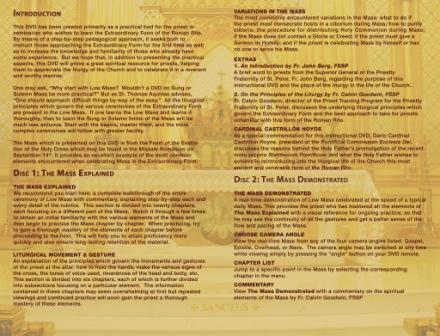 The term "Extraordinary Form" is used throughout.
The term "Extraordinary Form" is used throughout.
There are two disks. 1. The Mass Explained and 2. The Mass Demonstrated
There is an insert with the layout of the disk, et. all. Here is one page.
They also play on my computer in the DVD drive.
The Mass Explained is the meat and potatoes disk, while the Mass Demonstrated is the gravy.
The disks have interactive menus, with chapter lists so that you can navigate to what interests you.
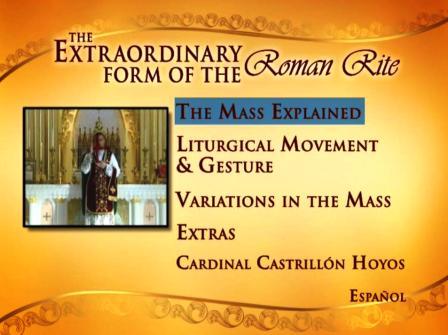
On The Mass Explained, there is a Mass which is explained in detail. But there is also another sector for how to make gestures, body postures, turns, bows, nods, etc. These are all clearly demonstrated.
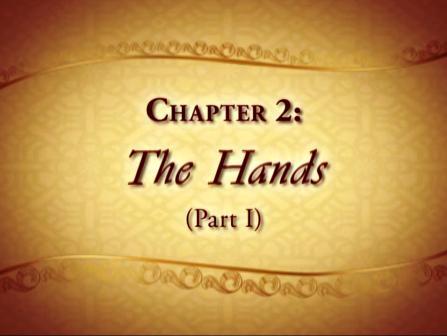
For the Mass itself, you see a Mass celebrated with running instructional commentary with ever changing camera angles.
The Mass Explained has the Low Mass appropriately for the Exaltation of the Cross (14 September), a day dear to us all. This Mass is useful, because the priest has a genuflection during the Epistle.
The instructions are both visual and oral. There seems to those in the know to be lots of extraneous detail but this pedantic detail will be welcome to priests and seminarians (bishops?) just starting out. Lay people could benefit from this as well.
There is an instruction to the priest to pray before Mass, using prayers in the Missal, before going to vest. This element reveals that the desire of the FSSP is to teach the priest to pray in a certain way when preparing to say Mass, in saying Mass, and also to give thanks afterward.
The DVD focuses not just on the priest, but also on the server. The vesting section shows the server how to lay vestments out for the priest. The vesting prayers are pronounced in Latin. I am not entirely satisfied with the clarity of the pronunciation and the volume drops compared to the narration of the instruction.
I was amused by a comment that the priest should have black shoes on. There is not mention of silver fibia or silver buckles! I guess a discalced Carmelite or other mendicant such as Franciscans were overlooked at this point, but I bet they will make the necessary adjustment. The same might be said about the biretta, talking about how the "middle fin" should be to the right. Not all liturgical birettas have only three points or fins. But this is not a big deal.
There are even demonstrations of how to fold a corporal. I am not kidding about the detail of the instruction.
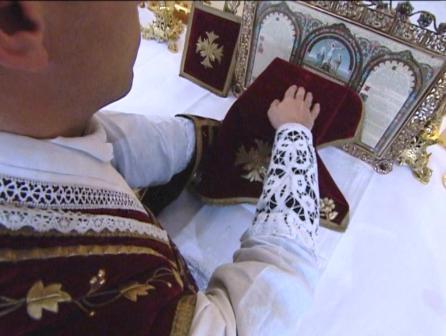
The server doesn’t kiss the hand/biretta at the beginning, but he attends to lifting the hem of the alb and cassock as he ascends.
I think some might quibble slightly with the way the priests turns, so as not to turn his back to the Blessed Sacrament.
There are many camera angles, which are very helpful. The transitions are good and smooth. I think they might use a little slow-motion to make sure you see what the priest does.
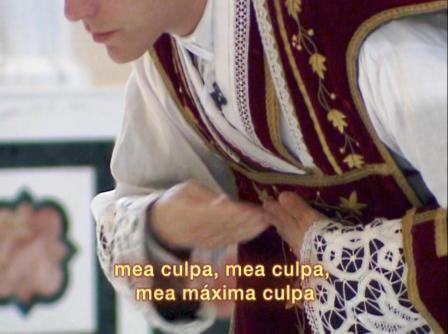
Text is flashed to accompany actions.
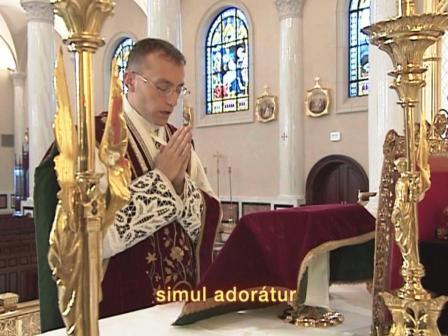
They also highlight some points that are going to be different from the Novus Ordo, such as the nine-fold Kyrie.
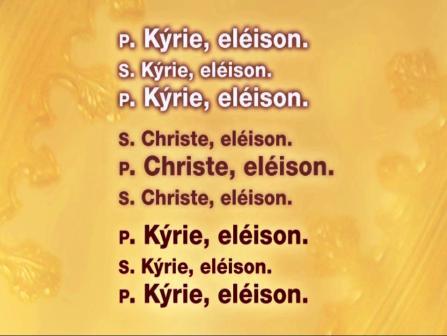
Animated graphics are used to show you the texts where actions are needed from the priest and then they show the priest doing what was explained. For example in the Gloria animated texts pop up to show when the priest bows his head. Very useful.
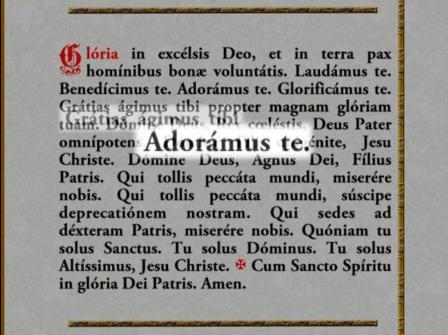
The video explains that the priest must memorize the conclusions for certain prayers.
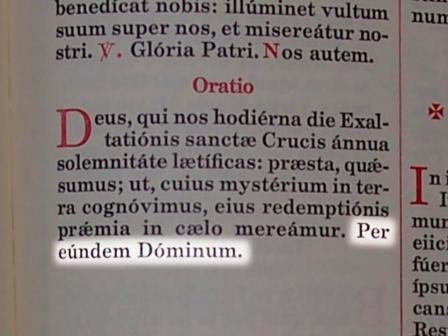
All along the way you are told when to speak loudly, or secretly, when you bow you head or bow your body and to what extent.
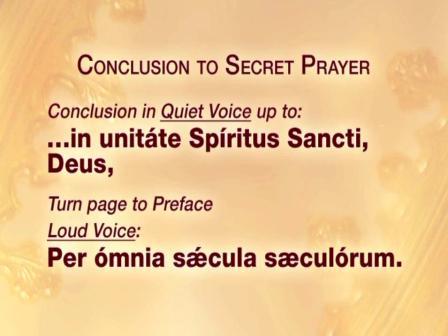
For the complicated moments, at least for beginners, such as the offertory and the actions before Communion, the DVD is invaluable. I think a newbie would be able to learn how to do everything well and smoothly from this DVD.
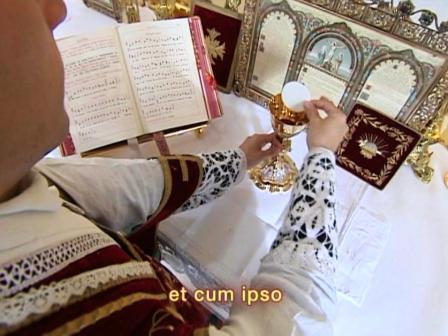
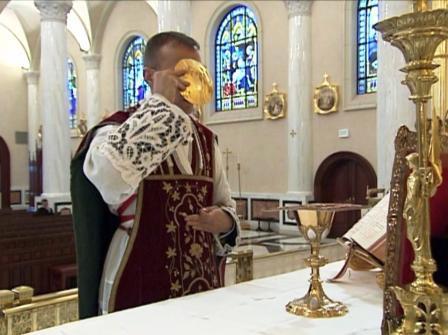
They show the priest back in the sacristry as well after Mass, blessing the server before the server then undresses the altar.
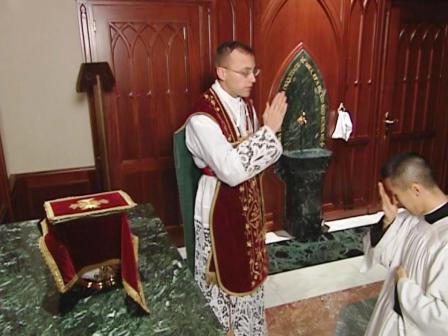
The "Variations in the Mass" section show you a Mass with a ciboria to be consecrated, where it should be placed, how to handle it, to cover and uncover, repose, and purify. You also see, as a variation, how to distribute Communion during Mass. you are instructed how to open the tabernacle, etc. There is no trace of the Second Confiteor. Of course the Second Confiteor is not in the 1962 Missale Romanum and that is what they are teaching. However, it might have been a good idea to show how to do this. The DVD explains Commemorations, which are a point of confusion for Mass. This is a rather extensive section. We are told about Masses with and without a Gloria and Creed. Preaching is covered.
Very useful is the Mass shown without a server, which a lot of men will want to know how to do, including variations in the texts to be prayed, as for example at the Confiteor and the response having nostri and nos. Where to put the water and wine, how to move the missal are all addressed.
On the second disk, The Mass Demonstrated might seem redundant at first, since the first disk was pretty detailed. What more could they do?
The Mass Demonstrated is simply a celebration of Mass without detailed instructional commentary in the default play. The many cameras are used appropriately in the default play. However, an added feature is that you can choose the camera angle you desire.
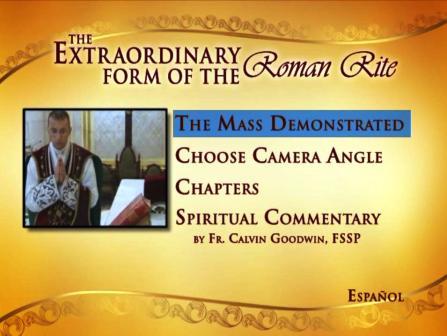
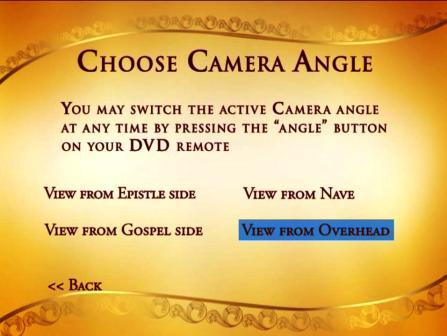
There is a slight glitch in the overhead angle when at the very beginning you catch the sandled foot of a camera guy, but, again, big deal. The ability to choose the camera angle could be very useful for the man trying to get a different view of some complex action: "How did he do that again?" – You can change your point of view so as to clarify questions.
The optional spiritual commentary by Fr. Goodwin, the priest in charge of the Training Program, is in a separate track you can choose, much as DVD’s of TV series or movies with have a director’s voice over. This commentary is directed especially for priests and seminarians. The commentary is tailored for the different moments of Mass, from the vesting to the return to the sacristy. It sounds like Fr. Goodwin has integrated also what Benedict XVI states in Sacramentum caritatis, especially about the priest getting out of the way so that the true action of the Mass can be clearer. As I listened to different parts of the Mass with the spiritual commentary, I found myself nodding my head, thinking that he got it just right. The comments also take a moment to underscore the meaning of a Communion Rail. There is a strong emphasis on silence, so lacking in so many churches. This is good, because that is a dimension of the older Low Mass which startles the newcomer and the newbie priest alike. Understanding the silence can help a nervous newbie priest, who has known nothing but the Novus Ordo in the usual noisy-jangly style of celebration, set aside the need to "talk" or "get busy".
Silence will be a constant theme of the comments. The commentary also draws in Scriptural references.
The style of celebration of the priest, the ars celebrandi is sober and careful without being precious, a fault of many traditional priests, in my opinion. This disk would be useful for the server, to learn what to do, though there is no shot of the credence table. With supplemental materials this lacuna can be easily filled.
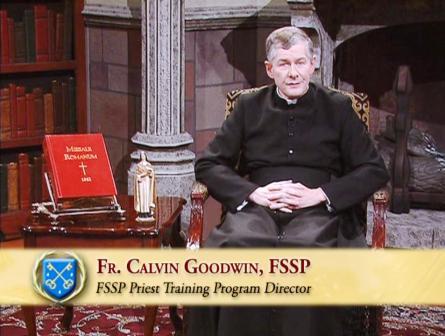
The Extras have a little talk by the Superior of the FSSP Fr. John Berg. There is also a talk by the priest in charge of the Training Program, Fr. Calvin Goodwin. He deals with some of the preconceptions and worries a priest might have about learning the older Mass. I like what he says about timidity and liturgical minimalism. He will leave Bishop Trautman unsatisfied when he says that "the ineffable is mediated by the sensible".
Fr. Goodwin talks about "conformity" and, something I have pounded at for years now, "receptivity". He clarifies that following rubrics is not mindless. Rather, even the external elements must not be undervalued. They must be a means for union with God. They mediate a deeper reality. Details matter. Conformity is also a means of freedom for true prayer. The priest must also be a good receiver of what he desire to pass on. Fr. Goodwin, when speaking of the receptivity of the faithful is exactly right. He explains well active receptivity.
Of course the DVD also has the now famous and long released video of His Eminence Dario Card. Castrillon Hoyos, President of the Pontifical Commission Ecclesia Dei.
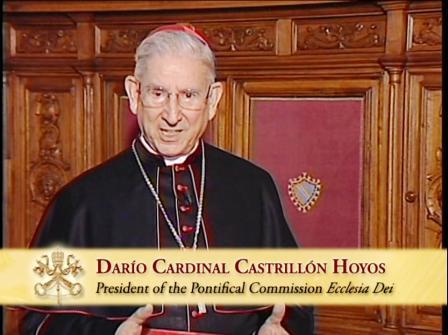
You will remember that His Eminence said about priests making the Extraordinary Form available:
"Even if it is not specifically asked for or requested, [priests] should make it available, so that everyone may have access to this treasure of the ancient liturgy of the Church. This is the primordial goal of the Motu Proprio [Summorum Pontificum]: a spiritual and theological richness."
Friends, get the DVD and use it. Learn this use of the Roman Rite, Reverend Fathers, and implement it in your parishes. You need not wait for requests.
Remember what Fr. Goodwin says in his presentation:
"The goals of the liturgy are not going to be advanced by clerical timidity or a liturgical minimalism. … Fear does no good. What is needed is trust."
UPDATE 13 Nov 15:00 GMT
I see that our friends at NLM also have a review. They have more screen shots than I have.
Bloggers! If you get this DVD let’s close ranks on this. We need to get this DVD into the hands of priests and seminarians. Create a little synergy here!


































Kind of a related question:
Why the Greek “Kyrie Eleison” in the Latin Mass? Why not also translate that?
Thanks
Mandarin and Cantonese!
Does Fr. Lee speak both?
I guess Japanese will have to wait until the ICRSS raises Deacon Ueda to the altar.
Fr. Z-
What about this as a Christmas present for priests? It seems like a natural, but then again….
Luke,
I’m pretty sure the Kyrie was kept in Greek when the western liturgy switched from greek to latin to maintain continuity with the east. Thats what I would presume anyways.
Fr. Z.
The beautiful Mass of my youth. Thank God. And my soul shall be healed.
JMJ
Tom Lanter
I pre-ordered more than a week ago and after reading this review I can’t wait for my DVDs to come!
Praise God that here on the border of Los Angeles and Orange Counties I know of about six weekly TLMs within reasonable driving distance. I’ve been going for more than a year and am pretty familiar with the TLM already, but studying this DVD should enhance my knowledge and understanding. I think really getting the words and gestures and their meanings into my head will in turn will help me even more to worship at Mass.
Is this DVD available to laymen to buy?
Blessings upon you, Father.
I thought there was a DVD also for laymen who wanted to learn more about the EFM. I can’t find it but I thought it already had been released. I’d like to have sort of a “Dinner & Learn” time where I invite people over, eat, fellowship, and then watch the video. Does anyone else know?
God bless the FSSP. They are just an outstanding group of priests! I know creating this video was hours and hours of hard work. Congratulations for what looks to be a well done piece!
Receptivity. Yes, I think that must be very important for everyone. When you’ve got your back up, when you wear a mask and a hard shell, you miss so much. When you really try to listen and take it all in, God seems to rush to fill your soul. Even when you’re having spiritual dryness problems, you have to try to be receptive to the stuff God is doing behind your back, as it were.
But priests have to be receptive just as laypeople do, or they will miss participating actively, too! :)
Spiritual and theological richness…You mean that doesn’t already exist with the NO, Your Eminence? Why would we need the EO for that? ;)
So when will there be an equally magnificent video for the Ordinary Form? ;)
Many thanks for posting this article about the dvd. Our diocese has a series of workshops to teach but I had several deaths occur here and couldn’t make them.
Is this DVD closed captioned? Or, do they plan on having captions for it?
The DVD sounds awesome. I wish they would publish one for training the altar servers. We had our servers retrained by a member of St John Cantius Community in Chicago…he fine tuned them so wonderfully. Our altar servers had never seen or observed the Tridentine Mass and so training them in six weeks was quite an intense and difficult job. I have to believe it (a training video for altar servers) would help other priests train the servers more easily.
Yeah, I could see closed captioning being useful for when priests or seminarians have to take their portable DVD player and hide in the closet to watch this video while Bishop or Pastor Schutzstaffel wanders the halls outside. “Vhat vas dat!”
But seriously, imagine how helpful this will be for the stifled seminarian or parochial vicar whose pastor is unreceptive to requests for the EF Mass. These guys can’t usually just say on the way out the door, “Cover all my weekday Masses for me, Father, I’m off to learn the Traditional Mass at a weeklong retreat.” So this is very good for men in their unfortunate situation.
The SSPX has offered an instructional video for this same purpose for quite some time. Has anyone seen it? If so, how does it compare to the new FSSP one? Here is the website for the SSPX video: http://www.sspx.org/for_the_clergy.htm
Was Fr Calvin Goodwin ordained by Archbishop Lefebvre?
Greg,
I doubt it. I understand Fr. Goodwin was a Jesuit before joining the FSSP.
ALL: I did not see a closed caption option.
This morning’s short reading of Lauds is still in mind, so I can only assume that all “creation waits with eager longing” (Romans 8:19) for their long since pre-ordered copies of this DVD. In the meantime, some might want to listen to Fr. Goodwin’s homily
http://ewtn.edgeboss.net/download/ewtn/multicast/audio/mp3/latin830.mp3
— delivered at that epoch-making first solemn high TLM shown on “global Catholic television” on 9/14/07 — which is still (I think) the finest single summary yet of the meaning and significance of Summorum Pontificum, perhaps especially for TLM-neophytes.
That is too cool!
I shall have to include it in Father’s Christmas present, this year!
The preview is stunning – I cannot wait to receive my ordered disc.
On a related note, I just received a DVD of the Documentary “Ecce + Fiat” about Clear Creek Monastery – also a beautiful production to familiarize our people with this tremendous monastery (which also maintains Mass and the Traditional Benedictine Office – in the Extraordinary Form – and has since its foundation).
For seminarians especially one might consider giving this AND a missal – those missals are pricey!
“So when will there be an equally magnificent video for the Ordinary Form? ;)”
My thoughts EXACTLY!
Just when DOES the celebrant (and the faithful, too?) bow their heads during the course of the Mass in the Extraordinary Form? I know about bowing the head at the invocation of the Trinity, at the name of Jesus, of Mary, and of the Saint(s) being celebrated.
Also during the Gloria at “adoramus te” (because of the word “adoramus”)?
And then also at “suscipe deprecationem”?
And during the Credo at “simul adoratur”?
Any other times I’m missing? Is it proper for the faithful to bow their heads too?
Franciscans customarily wear black shoes when celebrating the Old Rite, even if they wear sandals at
other times. They would keep piles of shoes in the sacristy.
John: The SSPX has offered an instructional video for this same purpose for quite some time. Has anyone seen it? If so, how does it compare to the new FSSP one?
I have never seen what the SSPX prepared, so I cannot say.
I’m afraid I may be the source of Matthew’s comment… and indeed was going to say something similar. But looking at the discussion of this point on the NLM, it appears there is some talk of there having been an indult to allow the wearing of sandals by some Franciscans (and perhaps other friars, though not Dominicans) at the altar.
http://www.haloscan.com/comments/stribe/114603440796525354/
A technical question, Father – will it work on a British machine?
(perhaps the producers could send a review copy to Blackfen for compatibility testing?)
can you still kiss the priests hand and the cruets in the 62 missal?
The video from the SSPX was great when it was the only thing available (though I was surprised by their omission of the use of the biretum for the priest approaching and departing the altar). I have seen it (SSPX) and even watched it several times before learning to celebrate the EF (live at OLGS of the FSSP). The production values of the FSSP video are far superior – given that it was actually filmed in a chapel which was designed as a state of the art broadcast studio (I do not say this as a criticism).
The new video is just one more indication of the seismic shift in the role of (what is now called) the Extraordinary Form within the church thanks to Summorum Pontificum. It is a welcome addition.
Richard T:
This might depend on the capabilities of your machine (whether it’s both PAL and NTSC). When I click on the order link at fsspdvd.com, the message indicates “Please note that this DVD is offered only in NTSC format. It will not work in overseas DVD players that use a PAL format..” Perhaps it would work on your PC though. Not sure whether region coding is implemented on this DVD, which could be a factor too.
Finally! I have been anxiously awaiting this for many months. Glad to see it is of amazing quality.
Thanks for the good news.
From Fr. Nolan:
Fr. Calvin Goodwin was the Priest for the Indult Mass in the Chapel at The Cathedral of the Immaculate Conception in Portland, Maine and he was also an advisor and a not infrequent guest at out “Trad Study Group.”
I was far from the only one who loved him and was both sad and happy for him when he left us. Sad because of our loss but happy for The FSSP and what he might mean in terms of a restoration.
He is everything one could want in a Priest. I love him.
I understand Fr. Goodwin was a Jesuit before joining the FSSP
True. In fact, members of our group met Fr. Devillers at the Jesuit Residence on the Campus of Cheverus High Scool in Portland, Maine where he was, among other things, a popular Latin Teacher.
He requested and received permission to join The FSSP. It broke our hearts that he left but we were happy for him.
He is the best.
“Also during the Gloria at “adoramus te” (because of the word “adoramus”)?
And then also at “suscipe deprecationem”?
And during the Credo at “simul adoratur”?
Any other times I’m missing? Is it proper for the faithful to bow their heads too?”
I am an altar server at a TLM Parish in Canada. I’ll do my best to answer you.
The celebrant does bow several times in the Gloria and Creed, but most of them are only slight bows (Adoramus Te is one of these). The faithful do not bow for these. At a High Mass, when the celebrant is finished the Gloria and is sitting at the sedilia, both he and the faithful bow for both “Jesu Christe”s and “Suscipe deprecationem nostram”. In the Creed the same thing goes for the “Simul adoratur”.
Hope that helps.
(The FSSP does offer a very good instructional DVD specifically aimed at training altar servers for the Low Mass. I purchased it several months ago and am very happy with it.)
It would be a great idea for people to give these instructional DVD’s to seminarians and priests for Christmas. I plan on purchasing the Complete Training Kit with DVD and donating it to my local archdiocesan seminary’s library.
Also, anyone may order materials from FSSP Publications Service.
Here is the FSSP Publications link: http://store.fraternitypublications.com/
For those who are so defensive about the omission of the second Confíteor (because it is not 1962), you should note that the Priest does not follow the 1962 rules regarding the bows at Orémus (and I would assume the same for the bows at the Most Holy Name, too). [for this take a look at one of the pictures posted on the NLM blog].
@ Sean,
I always thought that it was the best practice to have the servers bow at the appropriate parts of the Gloria and the Credo (especially if they are adults for whom it would not be difficult to do so). Also, I thought that a deep bow of the head (not a slight bow) was the most appropriate in these cases.
So far, I have only seen one book (French) that directs the servers not to make those reverences, but the author does not really give a good explanation as to why that should be so.
With regard to the faithful, if they are able to make these reverences, why not? However, it would be almost impossible to get them to do things in a coordinated and uniform manner… more could/should be expected from the people in the Sanctuary, though.
@ latinmass1983,
By no means am I saying that the servers or faithful can’t or shouldn’t make these reverences, but I’m saying that it’s not necessarily required (I personally do). At High Mass when the choir reaches the Jesu Christe(s), Suscipe, and Simul, a deep bow is made.
Also keep in mind that practice varies from Parish to Parish.